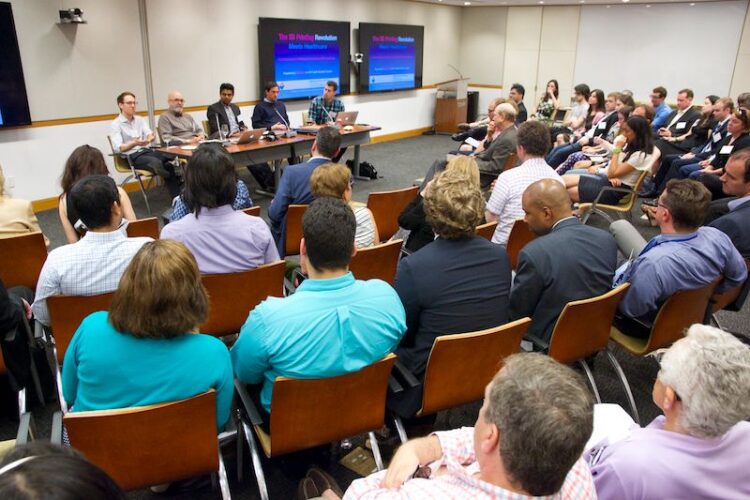Healthcare treatments and technologies, no matter how innovative, typically have finite potential. True revolutions with seemingly infinite applications are vanishingly rare – the ultimate disruptors. It is not to be taken lightly, then, when an experienced tech journalist who has immersed himself in this world, Mr. Land Grant, follows the likes of the personal computer, the world wide web, and social media with the technological platform he terms “the fourth disruptor”: 3D printing.
An exaggeration? In healthcare particularly, recent years have seen a number of touted “disruptors,” and a grain of salt is well-advised. Skeptics in this case would have done well to attend the NYC Health Business Leaders’ recent event, “The 3D Printing Revolution Meets Healthcare,” curated by Dr. Charlene Ngamwajasat, at which Grant (founder of 3DP Media) was amongst the illustrious, substantive panelists. I had been looking forward to this particular event for some time, and it did not disappoint. From sublime exoskeletons that augment congenital disabilities to deceptively quotidian orthodontist-free braces or almost any hearing aid, the breadth and depth of concrete, here-and-now solutions that 3DP (as it is known) offers to a range of healthcare quandaries is dizzying.
NYC Makers
Each of these is a solution already in play and NYC, and with its perfect storm of investors, techies, and creatives, it was uniformly agreed by panelists that the city would be the nexus of the 3DP universe – and healthcare its fastest growing market. Putting his money where his mouth is, moderator Joel Wishkovsky even moved to the city specifically to grow his personalized orthotics company out of that milieu. Other NYC-based 3DPers present included Dr. Abhi Datta – whose hundreds of 3DPed iterations on a transcranial electrode have allowed him to develop a product currently in world-wide clinical trials, with potential for non-invasive brain targeting in depression, Alzheimer’s, and fibromyalgia – and Jerry Castaños, whose retail 3DP storefront in Washington Heights can provide the expertise and equipment if you, too, have a 3DP dream to pursue.
Future, Ink.
As befitted an intelligent audience, however, the purpose of the event was not to dazzle with beautiful, innovative devices and “cool factor” (though Castaños’ sample prototypes offered plenty). The panel discussion was an insightful, high-yield primer that offered diverse, informed perspectives on the trajectory of the 3DP market, its particular promise for healthcare, as well as its practical limitations.
So, what are the predicted trends? As with so many other markets, open source software has done a lot to propel 3DP forward, a momentum that 3D Printing and Technology Funding portfolio manager John Meckler expects to continue to bring value to the industry. With this in mind, however, 3DP software may not be calling to you as the smartest investment. As technological capabilities continue to expand, 3DP devices and services are where it’s at, says Zack Schildhorn (VP of investment firm Lux Capital). Due to financial and logistical realities, he explained, not all 3DP products will be scalable, but those with a relatively high-value for size offer tremendous potential. Bypassing expensive orthodontists and a painful (and painfully unattractive) one-size-fits-all visible device, for example, InvisAlign has found success by opening an entirely new market for dental braces – adults and their dentists. Wishkovsky’s SOLS orthotics take a similar approach but at the other end of the spectrum, focusing more on one-offs, like hospitals and academic institutions, many of which have invested in the printers themselves. Such a resource allows nurse makers like presenter Victor Ty to tinker with iterative, innovative solutions to daily challenges of the in-patient ecosystem – such as a clip for eternally-slipping nasal cannulas developed at Maimonides Hospital – or surgeons to print patient-specific anatomy on which to “practice” before a particularly complex case. Great potential lies in making these devices available to creative, front-line professionals but, panelists agreed, logistics and technical expertise will dictate how much can realistically be accomplished on-site.
Regulating a One-Off
The most notable cloud in this rosy future comes in the form of the Food and Drug Administration (FDA). As Schildhorn posed the question, how does one obtain regulatory approval for an implanted device, such as a prosthetic hip, that is different for every patient? A head-scratcher, that. We seem trapped in an antiquated regulatory system, developed at a time when the very premise for such a conflict was unimagined. The current approach necessitates approximations and ad hoc operating room solutions in such circumstances, and is fundamentally incompatible with true, high-quality personalization.
Pursuit of a resolution raises important questions about how we wish to live, heal and create. From the practical perspective of a 3DP entrepreneur, Wishkovsky plainly stated, “I often come back to idea that maybe I … can [build my business] abroad, prove it, bring it back to the FDA and market it here later.” As an epicenter of 3DP’s creative revolution, NYC stands to lose a lot should other frustrated entrepreneurs be similarly inclined. With a more metaphysical but nevertheless eminently practical bent, Land insightfully frames the question thus: “If we really want the FDA to protect us from our patient-specific solutions, we may never get them. We may have to change expectations… [or] we may not get the ultimate cure.”
The evening was a complex, thought-provoking treatment of a truly disrupting healthcare sector that often gets only a glossy finish. In the vital pursuit of personalized healthcare, regulatory challenges raised at this event will be at the forefront, and must be thoroughly understood and addressed before we can realize potentials of which we now can only dream.




